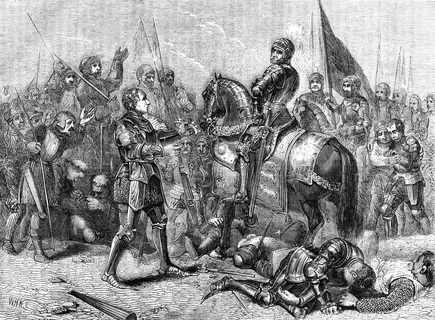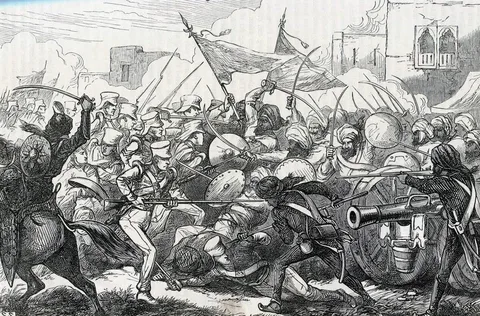The Battle of Domat-Ul-Gandal (5 Hijri) is a significant early military engagement during the time of the Prophet Muhammad that took place near Dumat al-Jandal, a strategic location on the northern edge of the Arabian Peninsula close to the borders of Ash-Sham (Greater Syria). This battle, occurring in the fifth year after the Hijra (5 AH, around 626 CE), was part of Muhammad’s efforts to extend the influence of the Muslims beyond Medina and to secure the trade routes from hostile tribes that threatened Muslim caravans and commerce.
The Battle of Domat-Ul-Gandal
Dumat al-Jandal was a vital commercial and military site situated approximately fifteen nights’ march from Medina. It lay on important caravan routes connecting Arabia to Syria and Iraq, making it crucial for controlling commerce and regional influence. The tribe of Qada’a, residing around Dumat al-Jandal, was known for raiding caravans and posing security threats. This tribe was allied with the Byzantine Empire, as the local governor was a Christian under the Roman (Byzantine) King, making this one of the first Muslim confrontations with forces linked to the Byzantine sphere.
After the Muslims had secured their position in Medina and consolidated power following earlier conflicts, intelligence reached the Prophet Muhammad that the tribes near Dumat al-Jandal had mobilized a large army and were conducting raids on Muslim caravans. These hostile actions prompted the Prophet to launch a campaign to preemptively neutralize the threat and expand Muslim control. This campaign also reflected a strategic goal to spread Islam and assert Muslim presence at the northern borders of the Arabian Peninsula.
The Campaign and Battle

In response, Prophet Muhammad departed from Medina with about 1000 companions, appointing Siba’a ibn Arfatah Al-Ghifari to govern Medina during his absence. The Muslim force traveled by night and hid during the day to achieve the element of surprise. Upon reaching Dumat al-Jandal, the Muslim army found that the hostile tribes had fled, leaving behind their cattle and shepherds, who were captured by the Muslims.
The Muslims stayed in the area for several days, dispatching patrols to find the enemy but encountering no resistance. During this time, the Prophet also negotiated a peace treaty with ‘Uyainah ibn Hisn, a local powerful figure who later embraced Islam. The tribes’ flight showed the effectiveness of the Muslim campaign in discouraging future raids on Muslim assets.
Though there was no direct large-scale battle due to the enemy’s flight, the expedition demonstrated Muslim military reach to the northern frontier, marking a significant strategic expansion. It also involved first confrontations with Christian forces allied to the Byzantines, sowing the seeds for further Muslim incursions beyond Arabia.
Read more: The battle of Hamraa’ Al-Asad (3 Hijri).
What were the short and long term effects
The Dumat al-Jandal campaign in 5 Hijri had several important short-term and long-term effects that influenced the early Muslim community’s military, political, and diplomatic standing. Here is an overview of these effects:
Short-Term Effects
-
Neutralization of Immediate Threats: The campaign successfully neutralized the immediate threat posed by hostile tribes near Dumat al-Jandal who were raiding Muslim caravans, thereby enhancing the security of Muslim trade routes.
-
Consolidation of Muslim Control: The expedition solidified Muslim control over the northern frontier of the Arabian Peninsula, signaling an increase in territorial and strategic influence.
-
Treaty and Alliances: The peace treaty with ‘Uyainah ibn Hisn and some local tribal leaders led to a reduction in hostilities and increased support for the Muslims, reinforcing diplomatic ties in the region.
-
Boost in Morale: The successful campaign without significant fighting demonstrated Muslim military reach and strategy, boosting the morale and confidence of the Muslim community.
Long-Term Effects
-
Expansion of Muslim Influence: The campaign marked the first significant Muslim expansion into northern Arabian territories near Byzantine lands, paving the way for future incursions and expansion beyond Arabia.
-
Securing Trade and Communication Routes: By subduing hostile tribes and establishing control of Dumat al-Jandal, the Muslims secured important trade routes that linked Arabia with Syria and Iraq, integral for economic stability and growth.
-
Increased Interaction with Byzantine Forces: This expedition was one of the initial conflicts involving forces allied with the Byzantine Empire, presaging later confrontations between the emerging Muslim state and Byzantine forces.
-
Foundation for Further Islamic Conquests: The campaign established a northern foothold that facilitated subsequent Muslim military campaigns and territorial expansion into the Levant and surrounding regions after the Prophet’s time.
-
Spreading Islam Beyond Arabia: The peaceful conversions and treaties with local leaders contributed to the gradual spread of Islam beyond the Arabian Peninsula into neighboring regions.
Read about: The battle of Badr Al-Akherah (4 Hijri).
Dumat al-Jandal: Prophet Muhammad’s Strategy
During the Dumat al-Jandal operation, Prophet Muhammad employed several tactical moves that demonstrated strategic acumen and military prudence:
-
Use of Surprise and Stealth: The Muslim army marched by night and concealed themselves by day, aiming to take the enemy by surprise. This tactic minimized the chance of early detection along the long march to Dumat al-Jandal.
-
Rapid and Coordinated Movement: The force covered a considerable distance (about fifteen days’ march) swiftly, impressing local tribes and deterring potential confrontations.
-
Psychological Warfare: The tribes in the area fled upon learning of the approaching Muslim force, indicating the psychological impact of Muhammad’s military reputation and the intimidating show of force.
-
Seizure of Enemy Resources: Although they did not engage in a large battle, the Muslims captured cattle and shepherds left behind by the fleeing tribes, which dealt a material blow to the enemy.
-
Extended Occupation and Reconnaissance: The Muslims stayed in the area for five days, sending out expeditionary patrols to locate and engage any remaining hostile forces, exemplifying thorough military discipline and caution.
-
Diplomatic Negotiation: Prophet Muhammad used the time to negotiate treaties with influential local leaders, such as ‘Uyainah ibn Hisn, which helped secure lasting peace treaties and alliances in the region.
Recommend: The battle of Bahran (3 Hijri).
FAQs
What was the main objective of the Battle of Domat-Ul-Gandal?
The primary objective was to stop raids by local tribes on Muslim caravans and extend the Muslim influence to the northern borders near Ash-Sham.
Did the battle involve direct combat?
There was minimal direct combat as the tribes fled before the Muslims arrived, but the Muslims captured their cattle and shepherds, showing military dominance.
Who led the Muslim forces in this battle?
Prophet Muhammad personally led the campaign with about 1000 companions.
What was the significance of the treaty with ‘Uyainah ibn Hisn?
The treaty helped stabilize the region, brought a powerful local leader into the Muslim fold, and reduced hostilities at Dumat al-Jandal.
How did the Battle of Domat-Ul-Gandal affect Muslim expansion?
It marked the first major Muslim expansion into the northern Arabian frontier, paving the way for future campaigns into Byzantine and other territories.
Conclusion
The Battle of Domat-Ul-Gandal in 5 Hijri, though not a conventional battle with direct large-scale combat, was a pivotal military expedition under the leadership of Prophet Muhammad. It was strategic both militarily and diplomatically, extending Muslim influence to the northern frontiers, securing key trade routes, and initiating engagements with Byzantine-affiliated forces. This expedition reflected the growing power and ambition of the early Muslim community, setting important foundations for the later Islamic conquests beyond Arabia.

